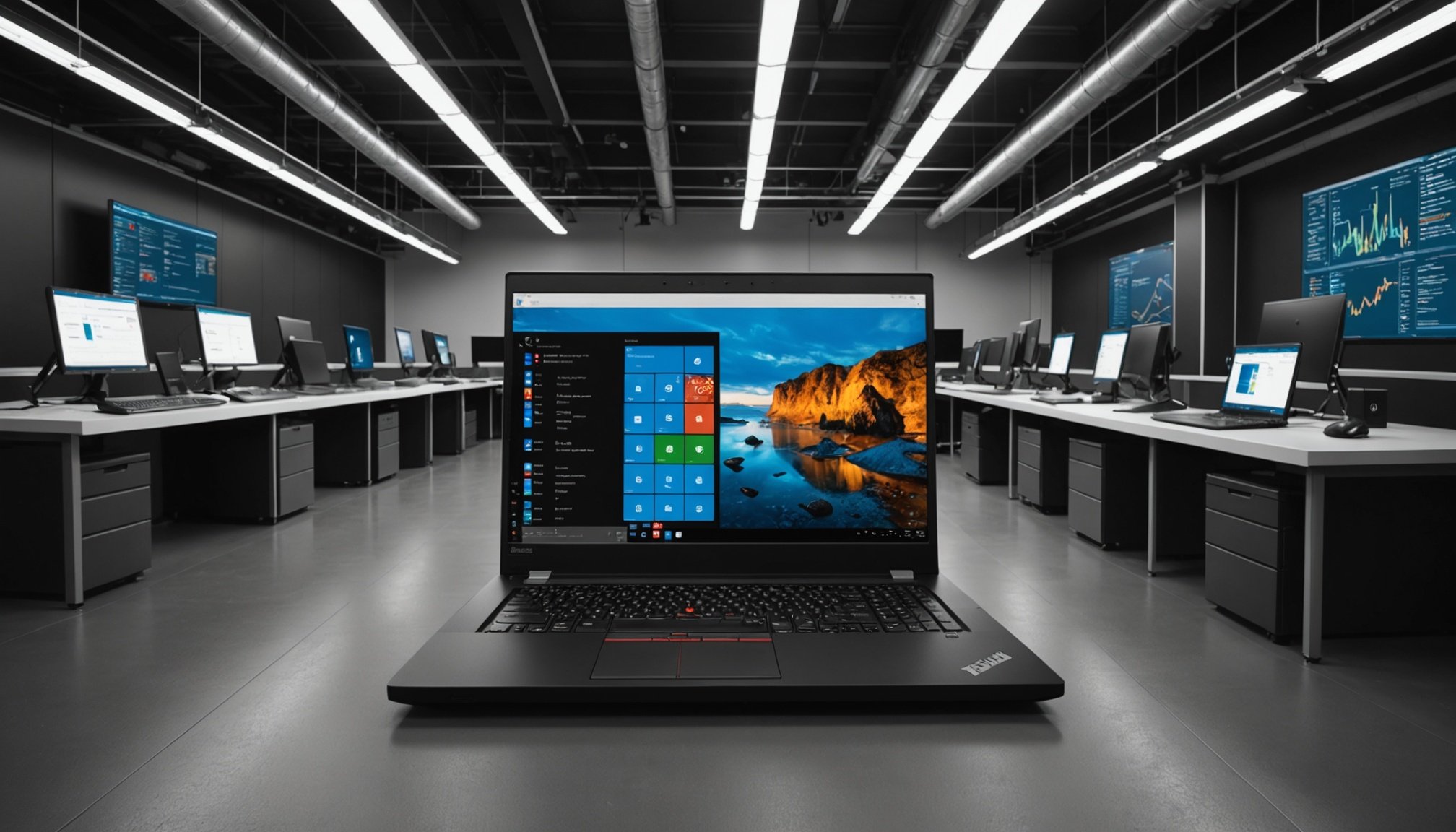Hardware Optimization Techniques
Enhancing the Lenovo ThinkPad P52 performance requires specific hardware optimizations tailored for machine learning tasks. To supercharge your device, consider upgrading RAM and storage. More RAM allows handling larger datasets and running more complex computations, which is crucial for data-heavy operations common in machine learning.
Transition to SSDs to substantially accelerate data retrieval during model training. SSDs offer faster read/write speeds compared to traditional hard drives, leading to quicker access times and enhancing overall processing efficiency.
Also read : Ultimate Setup Guide for Dell OptiPlex 7070 Micro Zoom Rooms: Your Step-by-Step Blueprint for Success
Thoughtful cooling solutions are paramount to maintain peak performance. Effective cooling helps prevent thermal throttling, ensuring the hardware runs efficiently without compromising on power, which is essential for intensive tasks.
When focusing on machine learning, each component plays a role in the broader capacity of the system. Enhancements in RAM, storage, and cooling collectively elevate the Lenovo ThinkPad P52 to meet the rigorous demands of machine learning, thus enabling a more seamless and responsive experience. Upgrading these components, therefore, acts as a foundational step in maximizing performance and reliability for machine learning professionals.
This might interest you : Mastering Machine Learning: A Comprehensive Guide to Installing and Optimizing a High-End GPU in Your Dell Precision 5820 Tower
Hardware Optimization Techniques
To boost the performance of your Lenovo ThinkPad P52 for machine learning tasks, consider implementing strategic hardware optimization techniques. Start by upgrading RAM. This enhancement allows for better data handling, essential during intense machine learning computations. More memory supports larger datasets and helps in faster model training.
Storage optimization is equally critical. Substitute traditional hard drives with SSDs (Solid State Drives) to accelerate data retrieval processes. Faster data access significantly reduces the time required for model training, contributing to overall efficiency.
Equally important is the implementation of effective cooling solutions. Machine learning tasks are demanding and generate substantial heat, potentially leading to thermal throttling. Thermal throttling can severely impact performance, as it forces the CPU and GPU to slow down to reduce temperature. Ensure your P52 has a robust cooling system that can handle extended periods of intensive computational tasks to maintain optimal performance.
Incorporating these upgrades and enhancements not only improves the performance of your Lenovo ThinkPad P52 but also extends its lifespan by maintaining stable operational conditions during demanding machine learning processes. Proper hardware optimization ensures your device is well-equipped to handle modern data science requirements.
Software Recommendations for Machine Learning
Selecting the right machine learning software is crucial for optimizing your P52 software setup. Machine learning libraries like TensorFlow, PyTorch, and Scikit-learn offer robust frameworks for varied applications, providing flexibility and power for both beginners and professionals. They support a range of algorithms and have active communities, facilitating continuous learning and problem-solving.
Choosing the best operating systems and environments is key to achieving optimal performance. Many users opt for Linux distributions, which often provide better support for machine learning drivers and frameworks. Additionally, using tools like Docker can help manage dependencies and ensure a consistent environment across different projects.
Integrating cloud services extends computational capabilities and provides scalable resources. Providers like AWS, Google Cloud, and Azure offer machine learning-specific services, allowing you to leverage cloud-based data science tools for increased efficiency and storage solutions. This is particularly beneficial for running extensive models or large datasets that exceed local hardware limits.
Configuring your software environment with these considerations can significantly improve your machine learning workflow on the Lenovo ThinkPad P52, ensuring you harness its full capabilities for your projects.
Software Recommendations for Machine Learning
When diving into machine learning on your Lenovo ThinkPad P52, leveraging the right software is crucial. Begin by exploring popular machine learning libraries and frameworks such as TensorFlow, PyTorch, and Scikit-learn. These tools provide a robust foundation for developing and testing models, offering diverse functionalities tailored to various machine learning tasks.
Selecting the best operating systems and environments is also vital. Ubuntu Linux is often preferred for its compatibility with machine learning packages and its resource efficiency, supporting an optimal machine learning software setup. This choice enhances the overall performance of long training sessions essential for developing complex models.
To further expand computational capability, consider integrating cloud services like AWS or Google Cloud. These platforms offer scalable resources, enabling your P52 to handle larger datasets and more extensive computations beyond its local hardware limits. Utilizing cloud-based solutions ensures that intensive processes don’t compromise your device’s performance.
By strategically selecting the right machine learning software and configurations, your ThinkPad P52 becomes a powerful tool ready to tackle demanding data science tools and tasks efficiently.
Troubleshooting Common Issues
When dealing with machine learning problems on the Lenovo ThinkPad P52, it’s essential to address common issues to maintain optimal performance. One frequent concern is overheating during intensive model training sessions. To tackle this, ensure that the cooling system is clean and functioning properly. Consider using software tools to monitor CPU and GPU temperatures, adjusting settings as needed.
Software conflicts can also impact performance. Commonly, these conflicts arise from incompatible library versions or faulty installations. It’s advisable to use virtual environments, such as Conda or virtualenv, to manage dependencies, reducing the risk of conflict. This approach keeps each project’s setup isolated, simplifying debugging processes.
Another prevalent issue is system instability. During lengthy training periods, ensuring a stable environment is critical. Power management settings should be configured to prevent unwanted hibernation or power-saving features that could interrupt processes. Calibrating these settings for performance rather than energy saving can further stabilize operations.
Optimizing the P52 troubleshooting aspects effectively helps in resolving common issues and sustaining smooth machine learning operations. Taking these steps can provide an adaptive and efficient platform for handling demanding computational tasks, assuring users of a reliable machine learning experience.
Configurations Specific to the ThinkPad P52
Fine-tuning your ThinkPad P52 settings is crucial for achieving the best performance in machine learning tasks. Tailor your configuration tips to maximise productivity and ensure an optimal machine learning setup.
BIOS Settings for Performance
Start by ensuring that your BIOS is up-to-date. This provides stability and unlocks enhancements necessary for improved system performance. A stable BIOS forms the backbone of your hardware’s efficiency, preventing potential compatibility issues during extensive computing tasks.
Power Management Tweaks
Adjusting power settings is essential to balance performance and battery life. In high-performance mode, the ThinkPad P52 prioritises computational power, crucial for extensive model training. Opt for balanced settings when focused on a mix of battery longevity and processing demands, allowing you to tailor your machine’s performance to specific needs.
GPU Configurations
Optimise GPU settings by enabling the discrete GPU for intensive machine learning work. This ensures computational tasks leverage the full power of the GPU, expediting processes like model training and increasing graphical workload efficiency. Tuning these specifications can significantly boost the laptop’s capabilities, offering a seamless and powerful user experience.
Configurations Specific to the ThinkPad P52
Optimising the Lenovo ThinkPad P52 settings is crucial for achieving the best performance in machine learning tasks. Tailoring the BIOS settings, power management, and GPU configurations can significantly enhance the efficiency of your machine learning setup.
BIOS Settings for Performance
Start by ensuring your BIOS is up-to-date. The latest updates often provide stability improvements essential for intensive tasks. Activating advanced power modes and performance-enhancing options in the BIOS can unlock potential hardware capabilities crucial for demanding computations.
Power Management Tweaks
Adjusting power settings balances performance and battery life. For machine learning, prioritising performance is key. Disable power-saving features that reduce CPU and GPU capabilities during training sessions. These settings ensure the ThinkPad P52 maintains high-performance levels, preventing interruptions in lengthy computations.
GPU Configurations
Maximise model training efficiency by optimising GPU settings. Install the latest drivers to ensure compatibility with machine learning software. Utilising tools like NVIDIA Control Panel allows custom configurations to enhance GPU processing power for complex model training tasks.
Implementing these targeted configurations ensures your Lenovo ThinkPad P52 operates at peak performance, efficiently handling machine learning workloads and maintaining stability during resource-intensive tasks.
Use Cases for Machine Learning on the P52
The Lenovo ThinkPad P52 shines in various machine learning applications, showcasing its versatility across multiple domains. By utilising the P52 for natural language processing, users can harness its robust computational power to handle complex linguistic tasks. This capability is invaluable in projects requiring text analysis, such as sentiment analysis and language translation.
In the realm of image recognition, the P52 excels through successful projects that depend heavily on GPU processing power. Its ability to train deep learning models quickly makes it a reliable choice for applications like facial recognition and autonomous vehicle systems, where speed and accuracy are essential.
Case studies often highlight the P52’s performance comparison against other laptops in similar benchmarks. Whether tackling complex algorithms or intensive calculations, its balanced configuration ensures that resource demands are met without compromise.
By exploring these real-world use cases, it’s evident that the ThinkPad P52 is not just a machine; it’s a powerful platform for innovation. Its ability to adapt to diverse projects speaks volumes about its capability to support creative solutions in the ever-evolving landscape of machine learning.
Use Cases for Machine Learning on the P52
When exploring machine learning applications on the ThinkPad P52, successful projects span across varied fields. Natural language processing (NLP) is a significant domain, showcasing how the P52 efficiently manages tasks like text analysis and sentiment detection. Advanced algorithms process vast amounts of textual data, offering valuable insights in real-time.
Another exciting area is image recognition, where the P52’s hardware capabilities shine. The device supports models trained to detect objects, classify images, and even perform facial recognition with high accuracy and speed. These tasks leverage the ThinkPad’s computational power effectively, proving its merit in visual data processing.
A comparative analysis reveals the P52’s standout performance, especially against other laptops in its category. Machine learning projects executed on this device often experience faster model training phases and more consistent outputs, thanks to its robust hardware optimization. For instance, in tasks challenging both computation and memory, the P52 demonstrates superior handling and output consistency, establishing it as a reliable option for rigorous machine learning endeavors.
Real-world case studies highlight the ThinkPad P52 as an exemplary tool in diverse projects, emphasizing its adaptability and effectiveness in addressing complex machine learning tasks.











